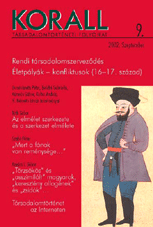Az elmélet szerkezete és a szerkezet elmélete. Szűcs Jenő középkor-képéről
Structures of a Theory and a Theory of Structures
Author(s): Gábor TóthSubject(s): History
Published by: KORALL Társadalomtörténeti Egyesület
Keywords: social history; historiography; theoretical and conceptual framework; Jenő Szűcs (historian); Middle Ages; Europe
Summary/Abstract: Jenő Szűcs was a medievalist, not a political scientist and thinker, although politics did form an organic part of his work. As a historian, he was convinced that „everything in history can be explained by deep structural causes” because „behind the ‘events’ there are certain structures that are essential in the long term.” In spite of this, his opusculum famosum, The Three Historical Regions of Europe: An Outline, has usually been hailed and interpreted as a document of East-European political dissent under the communist regime. This essay re-reads the text in terms of its theoretical-epistemological context to reconstruct a unique vision of historical processes that can be found behind its appealing surface. I argue that, notwithstanding the fact that his text is intoxicated with terms like structure, pattern, etc., Szűcs is misunderstood as a historian of orderly structures and unifying processes. Rather, as my re-reading of his various works reveals, he sought to restore the epistemological dignity of disorderly and destructive phenomena that, in his view, had a lasting positive influence on the formation of Europe. The appearance of an implicit straturalist approach in his oeuvre suggests that The Three Historical Regions of Europe ought not to be simply regarded as a political manifesto of a great historian and that it is time to acknowledge its theoretical import for the study of medieval history in general.
Journal: Korall - Társadalomtörténeti folyóirat
- Issue Year: 2002
- Issue No: 9
- Page Range: 137-154
- Page Count: 18
- Language: Hungarian

